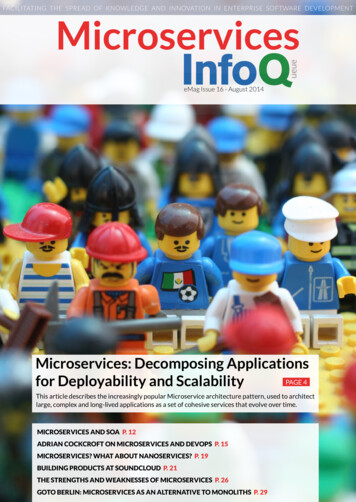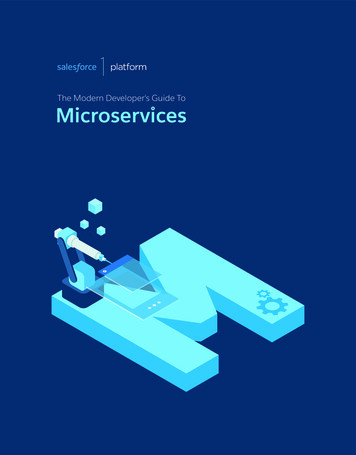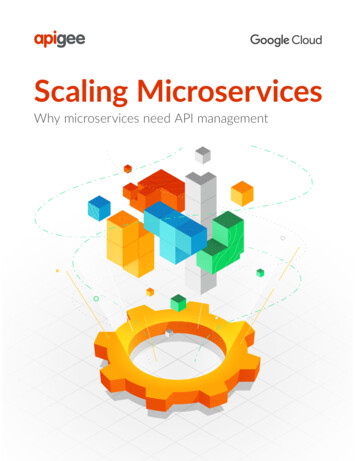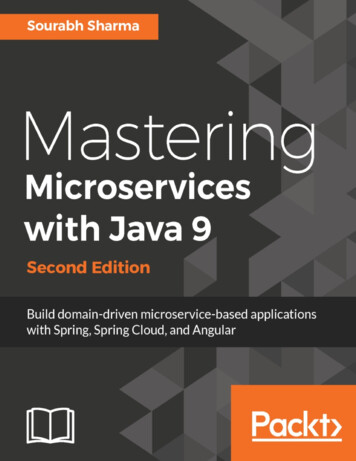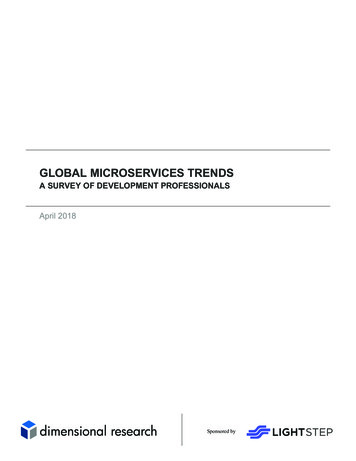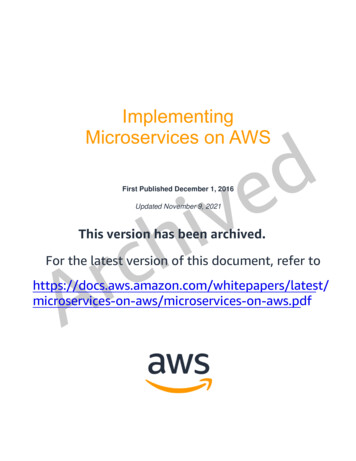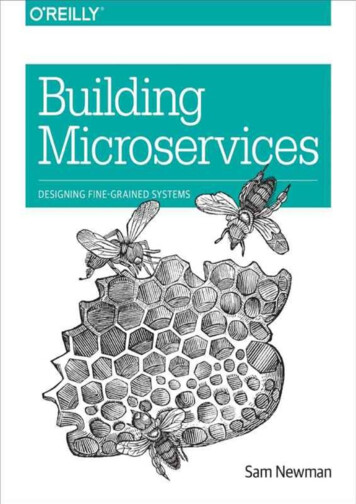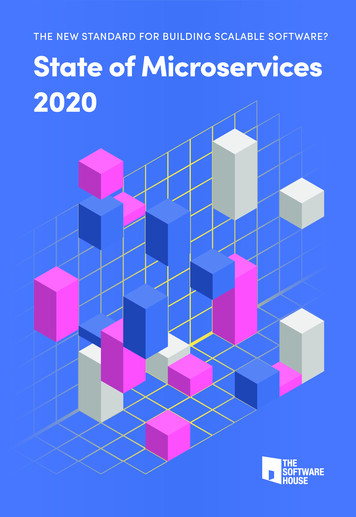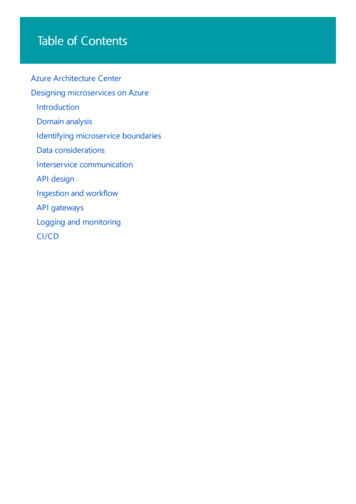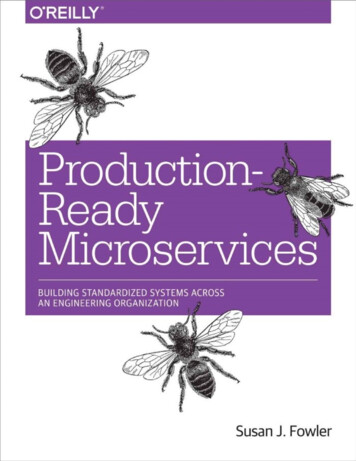
Transcription
Production-Ready MicroservicesBuilding Standardized Systems Across an Engineering OrganizationSusan J. Fowler
Production-Ready Microservicesby Susan J. FowlerCopyright 2017 Susan Fowler. All rights reserved.Printed in the United States of America.Published by O’Reilly Media, Inc., 1005 Gravenstein Highway North, Sebastopol, CA 95472.O’Reilly books may be purchased for educational, business, or sales promotional use. Onlineeditions are also available for most titles (http://oreilly.com/safari). For more information,contact our corporate/institutional sales department: 800-998-9938 or corporate@oreilly.com.Editors: Nan Barber and Brian FosterProduction Editor: Kristen BrownCopyeditor: Amanda KerseyProofreader: Jasmine KwitynIndexer: Wendy CatalanoInterior Designer: David FutatoCover Designer: Karen MontgomeryIllustrator: Rebecca DemarestDecember 2016: First Edition
Revision History for the First Edition2016-11-23: First ReleaseSee http://oreilly.com/catalog/errata.csp?isbn 9781491965979 for release details.The O’Reilly logo is a registered trademark of O’Reilly Media, Inc. Production-ReadyMicroservices, the cover image, and related trade dress are trademarks of O’Reilly Media,Inc.While the publisher and the author have used good faith efforts to ensure that the informationand instructions contained in this work are accurate, the publisher and the author disclaim allresponsibility for errors or omissions, including without limitation responsibility fordamages resulting from the use of or reliance on this work. Use of the information andinstructions contained in this work is at your own risk. If any code samples or othertechnology this work contains or describes is subject to open source licenses or theintellectual property rights of others, it is your responsibility to ensure that your use thereofcomplies with such licenses and/or rights.978-1-491-96597-9[LSI]
PrefaceThis book was born out of a production-readiness initiative I began running several monthsafter I joined Uber Technologies as a site reliability engineer (SRE). Uber ’s gigantic,monolithic API was slowly being broken into microservices, and at the time I joined, therewere over a thousand microservices that had been split from the API and were runningalongside it. Each of these microservices was designed, built, and maintained by an owningdevelopment team, and over 85% of these services had little to no SRE involvement, nor anyaccess to SRE resources.Hiring SREs and building SRE teams is an absurdly difficult task, because SREs are probablythe hardest type of engineers to find: site reliability engineering as a field is still relativelynew, and SREs must be experts (at least to some degree) in software engineering, systemsengineering, and distributed systems architecture. There was no way to quickly staff all of theteams with their own embedded SRE team, and so my team (the Consulting SRE Team) wasborn. Our directive from above was simple: find a way to drive high standards across the 85%of microservices that had no SRE involvement.Our mission was simple, and the directive was vague enough that it allowed me and my teama considerable amount of freedom to define a set of standards that every microservice at Ubercould follow. Coming up with high standards that could apply to every single microservicerunning within this large engineering organization was not easy, and so, with some help frommy amazing colleague Rick Boone (whose high standards for the microservices he supportedinspired this book), I created a detailed checklist of the standards that I believed every serviceat Uber should meet before being allowed to host production traffic.Doing so required identifying a set of overall, umbrella principles that every specificrequirement would fall under, and we came up with eight such principles: every microserviceat Uber, we said, should be stable, reliable, scalable, fault tolerant, performant, monitored,documented, and prepared for any catastrophe. Under each of these principles were separatecriteria that defined what it meant for a service to be stable, reliable, scalable, fault tolerant,performant, monitored, documented, and prepared for any catastrophe. Importantly, wedemanded that each principle be quantifiable, and that each criterion provide us withmeasurable results that dramatically increased the availability of our microservices. A servicethat met these criteria, a service that fit these requirements, we deemed production-ready.Driving these standards across teams in an effective and efficient way was the next step. Icreated a careful process in which SRE teams met with business-critical services (serviceswhose outages would bring the application down), ran architecture reviews with the teams, puttogether audits of their services (simple checklists that said “yes” or “no” to whether theservice met each production-readiness requirement), created detailed roadmaps (step-by-step
guides that detailed how to bring the service in question to a production-ready state), andassigned production-readiness scores to each service.Running the architecture reviews was the most important part of the process: my team wouldgather all of the developers working on a service in a conference room and ask them towhiteboard the architecture of their service in 30 minutes or less. Doing this allowed both myteam and the host team to quickly and easily identify where and why the service was failing:when a microservice was diagrammed in all of its glory (endpoints, request flows,dependencies and all), every point of failure stood out like a sore thumb.Every architecture review produced a great deal of work. After each review, we’d workthrough the checklist and see if the service met any of the production-readiness requirements,and then we’d share this audit out with the managers and developers of the team. Scoring wasadded to the audits when I realized that the production-ready or not idea was simply notgranular enough to be useful when we evaluated the production-readiness of services, so eachrequirement was assigned a certain number of points and then an overall score given to theservice.From the audits came roadmaps. Roadmaps contained a list of the production-readinessrequirements that the service did not meet, along with links to information about recentoutages caused by not meeting that requirement, descriptions of the work that needed to bedone in order to meet the requirement, a link to an open task, and the name of the developer(s)assigned to the relevant task.After doing my own production-readiness check on this process (also known as SusanFowler ’s-production-readiness-process-as-a-service), I knew that the next step would need tobe the automation of the entire process that would run on all Uber microservices, all of thetime. At the time of the writing of this book, this entire production-readiness system is beingautomated by an amazing SRE team at Uber led by the fearless Roxana del Toro.Each of the production-readiness requirements within the production-readiness standards andthe details of their implementation came out of countless hours of careful, deliberate work bymyself and my colleagues in the Uber SRE organization. In making the list of requirements,and in trying to implement them across all Uber microservices, we took countless notes,argued with one another at great length, and researched whatever we could find in the currentmicroservice literature (which is very sparse, and almost nonexistent). I met with a widevariety of microservice developer teams, both at Uber and at other companies, trying todetermine how microservices could be standardized and whether there existed a universal setof standardization principles that could be applied to every microservice at every companyand produce measurable, business-impactful results. From those notes, arguments, meetings,and research came the foundations of this book.It wasn’t until after I began sharing my work with site reliability engineers and softwareengineers at other companies in the Bay Area that I realized how novel it was, not only in theSRE world, but in the tech industry as a whole. When engineers started asking me for every
bit of information and guidance I could give them on standardizing their microservices andmaking their microservices production-ready, I began writing.At the time of writing, there exists very little literature on microservice standardization andvery few guides to maintaining and building the microservice ecosystem. Moreover, there areno books that answer the question many engineers have after splitting their monolithicapplication into microservices: what do we do next? The ambitious goal of this book is to fillthat gap, and to answer precisely that question. In a nutshell, this is the book I wish that I hadwhen I began standardizing microservices at Uber.
Who This Book Is Written ForThis book is primarily written for software engineers and site reliability engineers who haveeither split a monolith and are wondering “what’s next?”, or who are building microservicesfrom the ground up and want to design stable, reliable, scalable, fault-tolerant, performantmicroservices from the get-go.However, the relevance of the principles within this book is not limited to the primaryaudience. Many of the principles, from good monitoring to successfully scaling anapplication, can be applied to improve services and applications of any size and architectureat any organization. Engineers, engineering managers, product managers, and high-levelcompany executives may find this book useful for a variety of reasons, including determiningstandards for their application(s), understanding changes in organizational structure thatresult from architecture decisions, or for determining and driving the architectural andoperational vision of their engineering organization(s).I do assume that the reader is familiar with the basic concepts of microservices, withmicroservice architecture, and with the fundamentals of modern distributed systems —readers who understand these concepts well will gain the most from this book. For readersunfamiliar with these topics, I’ve dedicated the first chapter to a short overview ofmicroservice architecture, the microservice ecosystem, organizational challenges thataccompany microservices, and the nitty-gritty reality of breaking a monolithic applicationinto microservices.
What This Book Is NotThis book is not a step-by-step how-to guide: it is not an explicit tutorial on how to do each ofthe things covered in its chapters. Writing such a tutorial would require many, many volumes:each section of each of the chapters within this book could be expanded into its own book.As a result, this is a highly abstract book, written to be general enough that the lessons learnedhere can be applied to nearly every microservice at nearly every company, yet specific andgranular enough that it can be incorporated into an engineering organization and providereal, tangible guidance on how to improve and standardize microservices. Because themicroservice ecosystem will differ from company to company, there isn’t any benefit to befound in taking a step-by-step authoritative or educational approach. Instead, I’ve decided tointroduce concepts, explain their importance to building production-ready microservices,offer examples of each concept, and share strategies for their implementation.Importantly, this book is not an encyclopedic account of all the possible ways thatmicroservices and microservice ecosystems can be built and run. I will be the first to admitthat there are many valid ways to build and run microservices and microservice ecosystems.(For example, there are many different ways to test new builds aside from the staging-canaryproduction approach that I introduce and advocate for in Chapter 3, Stability and Reliability).But some ways are better than others, and I have tried as hard as possible to present only thebest ways to build and run production-ready microservices and apply each productionreadiness principle across engineering organizations.In addition, technology moves and changes remarkably fast. Whenever and whereverpossible, I have tried to avoid limiting the reader to an existing technology or set oftechnologies to implement. For example, rather than advocating that every microservice useKafka for logging, I present the important aspects of production-ready logging and leave thechoice of specific technology and the actual implementation to the reader.Finally, this book is not a description of the Uber engineering organization. The principles,standards, examples, and strategies are not specific to Uber nor exclusively inspired by Uber:they have been developed and inspired by microservices of many technology companies andcan be applied to any microservice ecosystem. This is not a descriptive or historical account,but a prescriptive guide to building production-ready microservices.
How To Use This BookThere are several ways you can use this book.The first approach is the least involved one: to read only the chapters you are interested in,and skim through (or skip) the rest. There is much to be gained from this approach: you’llfind yourself introduced to new concepts, gain insight on concepts you may be familiar with,and walk away with new ways to think about aspects of software engineering andmicroservice architecture that you may find useful in your day-to-day life and work.Another approach is a slightly more involved one, in which you can skim through the book,reading carefully the sections that are relevant to your needs, and then apply some of theprinciples and standards to your microservice(s). For example, if your microservice(s) is inneed of improved monitoring, you could skim through the majority of the book, reading onlyChapter 6, Monitoring, closely and then use the material in this chapter to improve themonitoring, alerting, and outage response processes of your service(s).The last approach you could take is (probably) the most rewarding one, and the one youshould take if your goal is to fully standardize either the microservice you are responsible foror all of the microservices at your company so that it or they are truly production-ready. Ifyour goal is to make your microservice(s) stable, reliable, scalable, fault tolerant,performant, properly monitored, well documented, and prepared for any catastrophe, you’llwant to take this approach. To accomplish this, each chapter should be read carefully, eachstandard understood, and each requirement adjusted and applied to fit the needs of yourmicroservice(s).At the end of each of the standardization chapters (Chapters 3-7), you will find a section titled“Evaluate Your Microservice,” which contains a short list of questions you can ask about yourmicroservice. The questions are organized by topic so that you (the reader) can quickly pickout the questions relevant to your goals, answer them for your microservice, and thendetermine what steps you can take to make your microservice production-ready. At the end ofthe book, you will find two appendixes (Appendix A, Production-Readiness Checklist, andAppendix B, Evaluate Your Microservice) that will help you keep track of the productionreadiness standards and the “Evaluate Your Microservices” questions that are scatteredthroughout the book.
How This Book Is StructuredAs the title suggests, Chapter 1, Microservices, is an introduction to microservices. It coversthe basics of microservice architecture, covers some of the details of splitting a monolith intomicroservices, introduces the four layers of a microservice ecosystem, and concludes with asection devoted to illuminating some of the organizational challenges and trade-offs thatcome with adopting microservice architecture.In Chapter 2, Production-Readiness, the challenges of microservice standardization arepresented, and the eight production-readiness standards, all driven by microserviceavailability, are introduced.Chapter 3, Stability and Reliability, is all about the principles of building stable and reliablemicroservices. The development cycle, deployment pipeline, dealing with dependencies,routing and discovery, and stable and reliable deprecation and decommissioning ofmicroservices are all covered here.Chapter 4, Scalability and Performance, narrows in on the requirements for building scalableand performant microservices, including knowing the growth scales of microservices, usingresources efficiently, being resource aware, capacity planning, dependency scaling, trafficmanagement, task handling and processing, and scalable data storage.Chapter 5, Fault Tolerance and Catastrophe-Preparedness, covers the principles of buildingfault-tolerant microservices that are prepared for any catastrophe, including commoncatastrophes and failure scenarios, strategies for failure detection and remediation, the ins andouts of resiliency testing, and ways to handle incidents and outages.Chapter 6, Monitoring, is all about the nitty-gritty details of microservice monitoring and howto avoid the complexities of microservice monitoring through standardization. Logging,creating useful dashboards, and appropriately handling alerting are all covered in this chapter.Last but not least is Chapter 7, Documentation and Understanding, which dives intoappropriate microservice documentation and ways to increase architectural and operationalunderstanding in development teams and throughout the organization, and also containspractical strategies for implementing production-readiness standards across an engineeringorganization.There are two appendixes at the end of this book. Appendix A, Production-ReadinessChecklist, is the checklist described at the end of Chapter 7, Documentation andUnderstanding, and is a concise summary of all the production-readiness standards that arescattered throughout the book, along with their corresponding requirements. Appendix B,Evaluate Your Microservice, is a collection of all the “Evaluate Your Microservice” questionsfound in the corresponding sections at the end of Chapters 3-7.
Conventions Used in This BookThe following typographical conventions are used in this book:ItalicIndicates new terms, URLs, email addresses, filenames, and file extensions.Constant widthUsed for program listings, as well as within paragraphs to refer to program elementssuch as variable or function names, databases, data types, environment variables,statements, and keywords.Constant width boldShows commands or other text that should be typed literally by the user.Constant width italicShows text that should be replaced with user-supplied values or by values determined bycontext.T IPThis element signifies a tip or suggestion.NOT EThis element signifies a general note.WARNINGThis element indicates a warning or caution.
O’Reilly SafariNOTESafari (formerly Safari Books Online) is a membership-based training and referenceplatform for enterprise, government, educators, and individuals.Members have access to thousands of books, training videos, Learning Paths, interactivetutorials, and curated playlists from over 250 publishers, including O’Reilly Media, HarvardBusiness Review, Prentice Hall Professional, Addison-Wesley Professional, Microsoft Press,Sams, Que, Peachpit Press, Adobe, Focal Press, Cisco Press, John Wiley & Sons, Syngress,Morgan Kaufmann, IBM Redbooks, Packt, Adobe Press, FT Press, Apress, Manning, NewRiders, McGraw-Hill, Jones & Bartlett, and Course Technology, among others.For more information, please visit http://oreilly.com/safari.
How to Contact UsPlease address comments and questions concerning this book to the publisher:O’Reilly Media, Inc.1005 Gravenstein Highway NorthSebastopol, CA 95472800-998-9938 (in the United States or Canada)707-829-0515 (international or local)707-829-0104 (fax)We have a web page for this book, where we list errata, examples, and any additionalinformation. You can access this page at http://bit.ly/prod-ready microservices.To comment or ask technical questions about this book, send email tobookquestions@oreilly.com.For more information about our books, courses, conferences, and news, see our website athttp://www.oreilly.com.Find us on Facebook: http://facebook.com/oreillyFollow us on Twitter: http://twitter.com/oreillymediaWatch us on YouTube: http://www.youtube.com/oreillymedia
AcknowledgmentsThis book is dedicated to my better half, Chad Rigetti, who took time away from buildingquantum computers to listen to all of my rants about microservices, and who joyfullyencouraged me every step of the way. I could not have written this book without all of his loveand wholehearted support.It is also dedicated to my sisters, Martha and Sara, whose grit, resilience, courage, and joyinspire me in every moment and aspect of my life, and also to Shalon Van Tine, who has beenmy closest friend and fiercest supporter for so many years.I am greatly indebted to all of those who offered feedback on early drafts, to my coworkers atUber, and to engineers who have bravely worked to implement the principles and strategieswithin this book at their own engineering organizations. I am especially thankful to Roxanadel Toro, Patrick Schork, Rick Boone, Tyler Dixon, Jonah Horowitz, Ryan Rix, KatherineHennes, Ingrid Avendano, Sean Hart, Shella Stephens, David Campbell, Jameson Lee, JaneArc, Eamon Bisson-Donahue, and Aimee Gonzalez.None of this would have been possible without Brian Foster, Nan Barber, the technicalreviewers, and the rest of the amazing O’Reilly staff. I could not have written this without you.
Chapter 1. MicroservicesIn the past few years, the technology industry has witnessed a rapid change in applied,practical distributed systems architecture that has led industry giants (such as Netflix, Twitter,Amazon, eBay, and Uber) away from building monolithic applications to adoptingmicroservice architecture. While the fundamental concepts behind microservices are not new,the contemporary application of microservice architecture truly is, and its adoption has beendriven in part by scalability challenges, lack of efficiency, slow developer velocity, and thedifficulties with adopting new technologies that arise when complex software systems arecontained within and deployed as one large monolithic application.Adopting microservice architecture, whether from the ground up or by splitting an existingmonolithic application into independently developed and deployed microservices, solvesthese problems. With microservice architecture, an application can easily be scaled bothhorizontally and vertically, developer productivity and velocity increase dramatically, and oldtechnologies can easily be swapped out for the newest ones.As we will see in this chapter, the adoption of microservice architecture can be seen as anatural step in the scaling of an application. The splitting of a monolithic application intomicroservices is driven by scalability and efficiency concerns, but microservices introducechallenges of their own. A successful, scalable microservice ecosystem requires that a stableand sophisticated infrastructure be in place. In addition, the organizational structure of acompany adopting microservices must be radically changed to support microservicearchitecture, and the team structures that spring from this can lead to siloing and sprawl. Thelargest challenges that microservice architecture brings, however, are the need forstandardization of the architecture of the services themselves, along with requirements foreach microservice in order to ensure trust and availability.
From Monoliths to MicroservicesAlmost every software application written today can be broken into three distinct elements: afrontend (or client-side) piece, a backend piece, and some type of datastore (Figure 1-1).Requests are made to the application through the client-side piece, the backend code does allthe heavy lifting, and any relevant data that needs to be stored or accessed (whethertemporarily in memory of permanently in a database) is sent to or retrieved from whereverthe data is stored. We’ll call this the three-tier architecture.Figure 1-1. Three-tier architectureThere are three different ways these elements can be combined to make an application. Mostapplications put the first two pieces into one codebase (or repository), where all client-sideand backend code are stored and run as one executable file, with a separate database. Othersseparate out all frontend, client-side code from the backend code and store them as separatelogical executables, accompanied by an external database. Applications that don’t require anexternal database and store all data in memory tend to combine all three elements into onerepository. Regardless of the way these elements are divided or combined, the applicationitself is considered to be the sum of these three distinct elements.Applications are usually architected, built, and run this way from the beginning of theirlifecycles, and the architecture of the application is typically independent of the productoffered by the company or the purpose of the application itself. These three architecturalelements that comprise the three-tier architecture are present in every website, every phoneapplication, every backend and frontend and strange enormous enterprise application, and arefound as one of the permutations described.In the early stages, when a company is young, its application(s) simple, and the number ofdevelopers contributing to the codebase is small, developers typically share the burden ofcontributing to and maintaining the codebase. As the company grows, more developers arehired, new features are added to the application, and three significant things happen.First comes an increase in the operational workload. Operational work is, generally speaking,the work associated with running and maintaining the application. This usually leads to thehiring of operational engineers (system administrators, TechOps engineers, and so-called“DevOps” engineers) who take over the majority of the operational tasks, like those related tohardware, monitoring, and on call.
The second thing that happens is a result of simple mathematics: adding new features to yourapplication increases both the number of lines of code in your application and the complexityof the application itself.Third is the necessary horizontal and/or vertical scaling of the application. Increases in trafficplace significant scalability and performance demands on the application, requiring that moreservers host the application. More servers are added, a copy of the application is deployed toeach server, and load balancers are put into place so that the requests are distributedappropriately among the servers hosting the application (see Figure 1-2, containing afrontend piece, which may contain its own load-balancing layer, a backend load-balancinglayer, and the backend servers). Vertical scaling becomes a necessity as the application beginsprocessing a larger number of tasks related to its diverse set of features, so the application isdeployed to larger, more powerful servers that can handle CPU and memory demands(Figure 1-3).Figure 1-2. Scaling an application horizontally
Figure 1-3. Scaling an application verticallyAs the company grows, and the number of engineers is no longer in the single, double, oreven triple digits, things start to get a little more complicated. Thanks to all the features,patches, and fixes added to the codebase by the developers, the application is now thousandsupon thousands of lines long. The complexity of the application is growing steadily, andhundreds (if not thousands) of tests must be written in order to ensure that any change made(even a change of one or two lines) doesn’t compromise the integrity of the existingthousands upon thousands of lines of code. Development and deployment become anightmare, testing becomes a burden and a blocker to the deployment of even the most crucialfixes, and technical debt piles up quickly. Applications whose lifecycles fit into this pattern(for better or for worse) are fondly (and appropriately) referred to in the softwarecommunity as monoliths.Of course, not all monolithic applications are bad, and not every monolithic applicationsuffers from the problems listed, but monoliths that don’t hit these issues at some point intheir lifecycle are (in my experience) pretty rare. The reason most monoliths are susceptibleto these problems is because the nature of a monolith is directly opposed to scalability in themost general possible sense. Scalability requires concurrency and partitioning: the two thingsthat are difficult to accomplish with a monolith.
S CALING AN AP P LICAT IONLet’s break this down a bit.The goal of any software application is to process tasks of some sort. Regardless of what those tasks are, we can make ageneral assumption about how we want our application to handle them: it needs to process them efficiently.To process tasks efficiently, our application needs to have some kind of concurrency. This means that we can’t have justone process that does all the work, because then that process will pick up one task at a time, complete all the necessarypieces of it (or fail!), and then move onto the next — this isn’t efficient at all! To make our application efficient, we canintroduce concurrency so that each task can be broken up into smaller pieces.The second thing we can do to process tasks efficiently is to divide and conquer by introducing partitioning, where eachtask is not only broken up into small pieces but can be processed in parallel. If we have a bunch of tasks, we can processthem all at the same time by sending them to a set of workers that can process them in parallel. If we need to processmore tasks, we can easily scale with the demand by adding additional workers to process the new tasks without affectingthe ef
introduce concepts, explain their importance to building production-ready microservices, offer examples of each concept, and share strategies for their implementation. Importantly, this book is not an encyclopedic account of all the possible ways that microservices and microservice ecosystems can be built and run. I will be the first to admit
